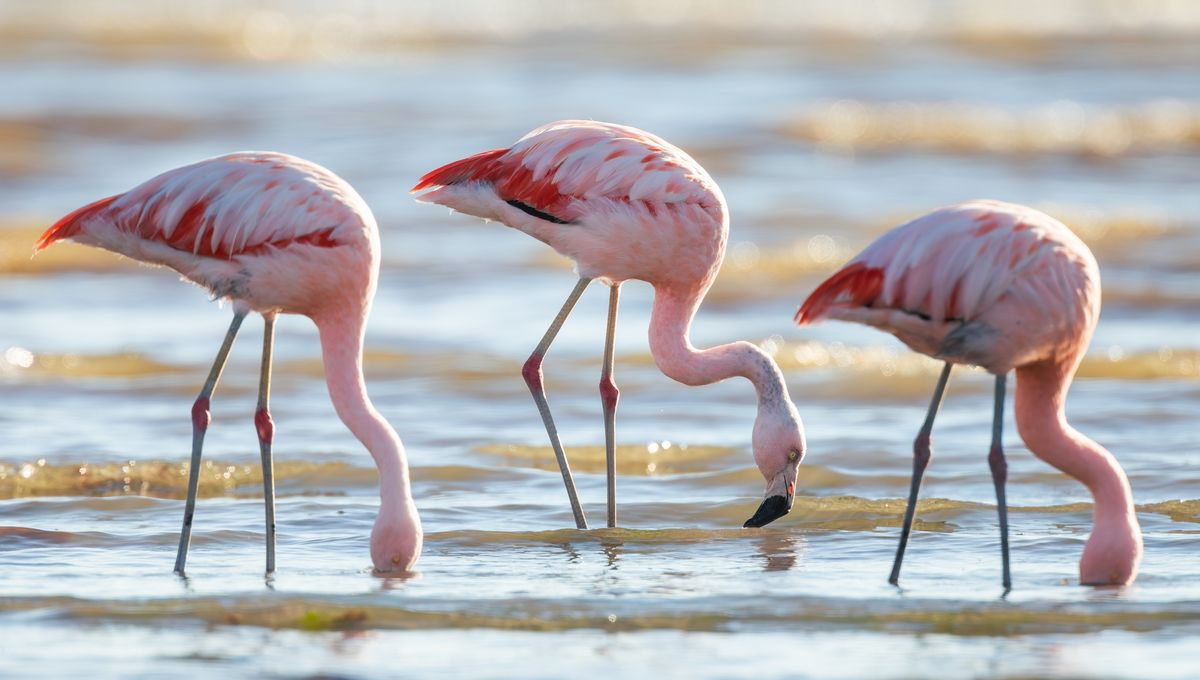
Flamingos are not passive filter feeders, but active hunters of prey, a new study reveals. Instead of chasing their diverse diet, they create disturbances in the water that force the food items to come to them, a much more efficient approach.
The curiosity a trip to Zoo Atlanta inspired in Dr Victor Ortega Jiménez of the University of California, Berkeley has led to an extensive quest to understand the feeding behavior of flamingos. The activity beneath the water line turns out to be remarkably complex, and could provide valuable tips for how humans could concentrate objects in water, such as microplastics for removal.
Flamingos feed on everything suitably sized in shallow water, from brine shrimp to insect larvae and insects themselves. Famously their color comes from carotenoids in blue-green algae they either eat directly, or consume through aquatic algal-feeding animals. What has only been discovered now is how they maximize the concentration of their food, so they do not need to sweep through too much water to meet their needs.
Ortega Jiménez could only see ripples on the surface when the zoo’s flamingos were feeding, but he thought more must be going on beneath. His quest led him to film flamingos feeding with underwater cameras, lighting up bubbles in the water with lasers to detect the underlying movement.
To confirm what was happening, Ortega Jiménez and colleagues not only developed computer models of water dynamics, but 3D printed flamingo beaks and feet to see how their shape and movement affected the water. The quest continued at four universities spanning America.
In the process, Ortega Jiménez and co-authors have proved that flamingos combine the way they move their feet and the chattering of their distinctively shaped bills to create vortices that direct water towards the bill. The vortices spin so fast that brine shrimp or fast-moving water boatmen can seldom escape the flamingos’ hunt.
The process starts with the way flamingos’ webbed feet stir the water. Humans can find it hard to escape mud, because when we lift our boots out of it partial vacuums left behind apply suction that pulls us back. Water birds have evolved a solution using floppy webbing that reshapes itself to prevent suction effects.
When Ortega Jiménez compared models of stiff and floppy webbed feet, he discovered this feature provides an additional advantage for flamingos, squeezing out sediment vortices rich in food items as they raise their feet. Spreading the feet on the downstroke and folding the webs on the up maximizes the effect.
The L-shaped flamingo beak makes a second vortex, which concentrates food items towards it when drawn straight up through the water.
Keeping the upper beak still and flat to the lakebed while quickly chattering the lower beak provides the final piece in the puzzle so far. It may also be the most powerful feature, increasing prey capture seven times over, replicas suggest.
“We observed when we put a 3D printed model in a flume to mimic what we call skimming, they are producing symmetrical vortices on the sides of the beak that recirculate the particles in the water so they actually get into the beak,” Ortega Jiménez said in a statement.
“Flamingos are super-specialized animals for filter feeding,” he said. “It’s not just the head, but the neck, their legs, their feet and all the behaviors they use just to effectively capture these tiny and agile organisms.”
Flamingos aren’t the only beneficiaries either. Wilson’s phalaropes feed around Chilean flamingos, and have been found to double their food intake when they do, which the authors attribute to the flamingo stomping.
Ortega Jiménez isn’t finished, however. The flamingo’s powerful tongue is known to pump water like a piston, and he thinks there’s more we can learn about how this works. The beak is also lined with lamellae that resemble combs or whale baleen, capturing prey to be scooped from the water, and he thinks there’s more to this apparently simple process than meets the eye.
Ortega Jiménez also wants to know whether other animals use a similar approach, noting southern right whales, despite lacking flamingos’ body shape, also capture plankton near the seafloor and might make similar vortices.
No wonder, as Stephen Jay Gould pointed out, the severe frown flamingos appear to wear when upright hides a secret smile when feeding.
The study is published open access in Proceedings of the National Academy of Sciences.
Source Link: Flamingos Make Tiny Tornadoes In Water To Trap Their Prey